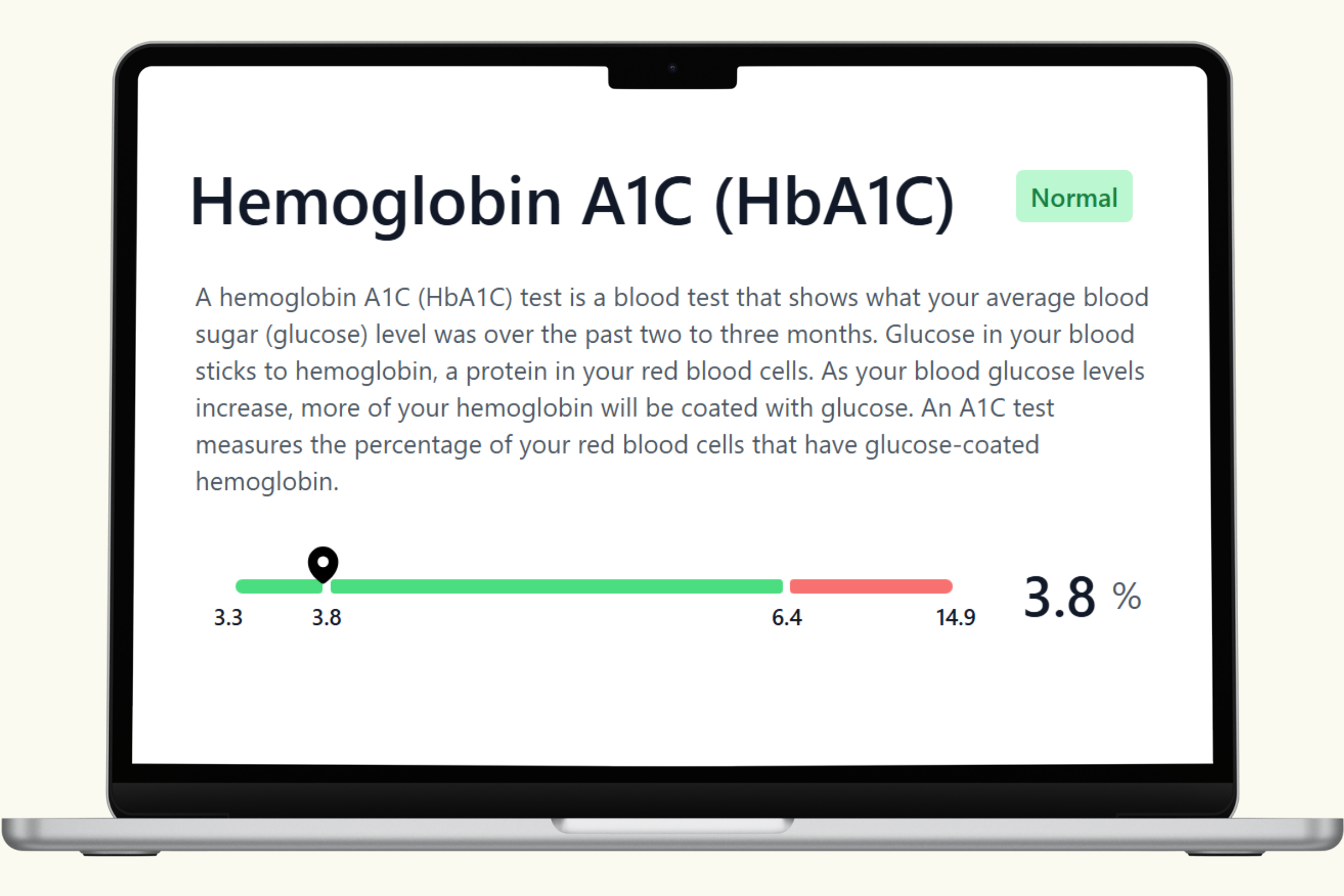Hemoglobin A1C (HbA1C) Blood Test
The Hemoglobin A1C (HbA1C) Test is one of the most important tools for evaluating long-term blood sugar control. Unlike a fasting glucose test, which only shows your blood sugar at a single point in time, the HbA1C test measures your average blood glucose levels over the past 2–3 months. It does this by analyzing the percentage of hemoglobin (a protein in red blood cells that carries oxygen) that is coated, or glycated, with glucose. The higher your blood sugar levels, the more glucose attaches to hemoglobin.
As part of the PlexusDx Diabetes & Heart Health Blood Test, the HbA1C test provides critical insight into your risk for type 2 diabetes, prediabetes, and diabetes complications—all with the convenience of at-home dried blood spot (DBS) collection using an ADX card.
What the HbA1C Test Measures
This test measures the percentage of glycated hemoglobin in your blood. Because red blood cells live for about 120 days, the HbA1C result reflects your average glucose levels during that lifespan. This makes it a powerful marker for detecting early blood sugar imbalances and monitoring diabetes management.
Why HbA1C Matters
Blood sugar naturally fluctuates throughout the day depending on meals, activity, stress, and hormones. However, persistently high glucose levels damage blood vessels, nerves, and organs over time, increasing the risk of diabetes complications such as:
- Heart disease and stroke
- Kidney disease
- Nerve damage (neuropathy)
- Eye disease (retinopathy)
- Poor wound healing and circulation problems
Because HbA1C reflects long-term patterns, it provides a clearer picture of your overall metabolic health than a single blood glucose reading. It is also one of the primary tests used to diagnose type 2 diabetes and prediabetes.
Reference and Functional Ranges
According to standard medical guidelines, HbA1C results are classified as:
- Normal: Less than 5.7%
- Prediabetes: 5.7% – 6.4%
- Diabetes: 6.5% or higher
In functional and preventive medicine, the optimal target is often considered closer to 4.8% – 5.2% for supporting long-term metabolic resilience and reducing risk of complications, even before prediabetes develops.
How the Test is Collected
The PlexusDx Diabetes & Heart Health Blood Test uses a dried blood spot (DBS) collection method with an ADX card. After a simple finger prick, you place a few drops of blood on the card and mail it to the lab. This method is:
- Convenient and private
- No fasting required
- Accurate and clinically validated
- Ideal for routine monitoring of diabetes and prediabetes
Factors That Influence HbA1C Levels
Several factors can affect HbA1C levels beyond blood sugar alone:
- Diet: High intake of refined carbs and sugars raises long-term glucose exposure.
- Exercise: Regular activity improves insulin sensitivity and lowers average glucose.
- Weight: Excess body fat, especially abdominal fat, increases insulin resistance and HbA1C.
- Stress: Elevated cortisol can raise glucose levels over time.
- Sleep: Poor or irregular sleep contributes to higher glucose and HbA1C.
- Medical conditions: Diabetes, prediabetes, kidney disease, and anemia can all impact HbA1C results.
- Medications: Certain drugs, including steroids and some antipsychotics, can raise glucose and HbA1C.
How to Improve HbA1C
Improving HbA1C levels is achievable with consistent lifestyle strategies and, when needed, medical treatment:
- Eat a balanced diet: Emphasize whole foods, fiber-rich vegetables, lean proteins, and healthy fats. Limit refined carbs and sugary foods.
- Exercise regularly: Both aerobic activity and strength training help reduce average glucose levels.
- Maintain a healthy weight: Even modest weight loss can lower HbA1C and improve insulin sensitivity.
- Manage stress: Mind-body practices such as meditation, yoga, or deep breathing can help regulate cortisol and blood sugar.
- Prioritize sleep: Aim for 7–9 hours of quality sleep per night to support glucose regulation.
- Medical therapy: For those with diabetes, medications like metformin, insulin, or newer classes of glucose-lowering drugs may be needed under professional care.
Why Pair HbA1C with Other Biomarkers?
While HbA1C is powerful on its own, it is even more informative when combined with other markers. The PlexusDx Diabetes & Heart Health Blood Test also includes fasting glucose, lipid markers (LDL, HDL, VLDL, triglycerides), and cholesterol ratios. Together, these results provide a full view of both cardiovascular and metabolic health, helping you take action early and track progress over time.
Take Charge of Your Metabolic Health
The Hemoglobin A1C Test offers a long-term perspective on your blood sugar control, making it one of the most valuable tests for preventing and managing diabetes. With PlexusDx’s at-home collection, you can easily monitor your HbA1C levels, identify risks early, and take meaningful steps toward healthier glucose regulation. By combining your results with positive lifestyle choices and medical guidance when needed, you can lower your risk of complications and support lifelong wellness.

Share:
Cholesterol Blood Test